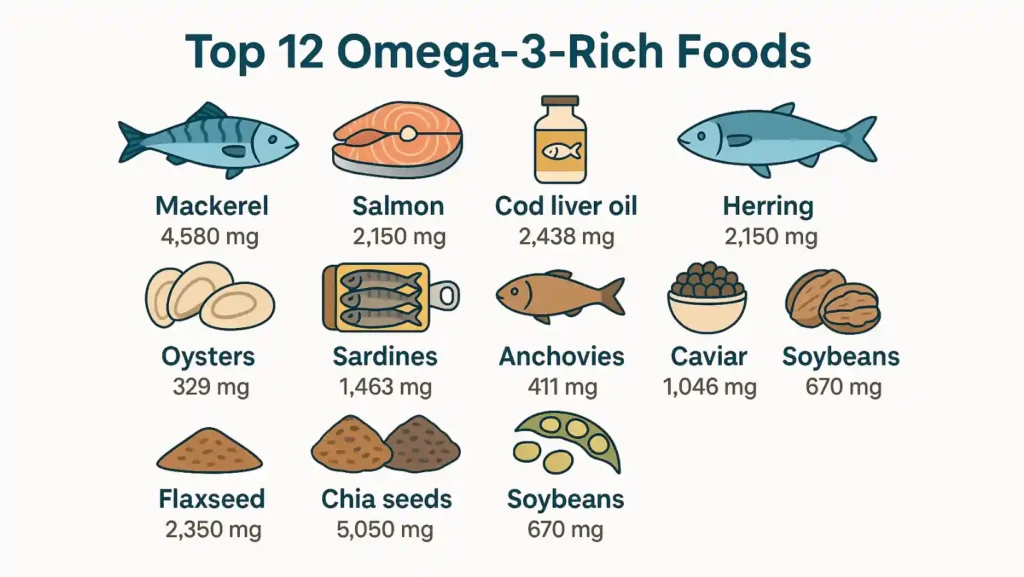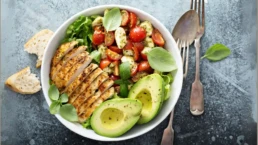Foods high in omega 3 are vital for both heart and brain. These essential fats are not made by the body, so you must get them from your meals. Omega-3s include three main types: ALA (Alpha-linolenic acid) from plants, and EPA (Eicosapentaenoic acid) and DHA (Docosahexaenoic acid) from fish and marine sources. Studies from the WHO (World Health Organization) and the NIH (National Institutes of Health) show that diets rich in omega-3s lower risks of cardiovascular disease, dementia, depression, and type 2 diabetes.
Table of Contents
ToggleThis guide lists 12 powerful omega 3 rich foods, explains their nutrient benefits, and shares easy ways to add them to daily meals. If you want a clear omega 3 foods list, this breakdown gives you the details and numbers you need.
Mackerel – One of the Best Sources of Omega-3 (4,580 mg per serving)

Mackerel tops nearly every chart of best sources of omega 3. Just 100 grams delivers about 4,580 mg of combined EPA and DHA, making it one of the densest omega 3 fatty acids foods. Mackerel is also a fatty fish (salmon, mackerel, sardines, tuna), meaning it is loaded with other nutrients like vitamin D, vitamin B12, and selenium.
Eating mackerel twice a week helps with inflammation reduction, keeping arteries flexible, and improving cognitive function. For families, grilled or baked mackerel is simple and budget-friendly. However, large king mackerel can have higher mercury, so choose Atlantic or Pacific mackerel, which are safer.
Fun fact: In Japanese diets, mackerel is a staple fish served grilled with miso soup. This cultural habit aligns with Japan’s lower rates of heart disease compared to the West.
Salmon – Omega-3 Rich Food for Heart Health (2,150 mg per serving)
Salmon is one of the most recognized omega 3 rich foods. A single serving has about 2,150 mg of EPA and DHA. Studies show that people who eat salmon at least twice a week have a lower risk of fatal cardiovascular disease.
Salmon is also a source of protein, vitamin D, and B vitamins (general). Farmed salmon contains slightly less omega-3 than wild-caught, but both are still excellent. Try it grilled, baked, or in sushi.
Salmon’s omega 3 benefits include boosting blood flow, helping manage inflammation, and protecting against depression. It is also one of the easiest fish to find worldwide, making it a reliable choice for families.
Cod Liver Oil – Best Omega-3 Fish Oil Supplement (2,438 mg per serving)
Cod liver oil is often sold as capsules and is considered the best fish oil supplement. One spoon contains over 2,400 mg of omega-3s along with vitamin A and vitamin D. This makes it a complete nutrient powerhouse.
Doctors may suggest cod liver oil as a best omega 3 supplement for people who don’t eat fish. However, since it is strong, dosage must be moderate. Too much Vitamin A can be harmful.
Cod liver oil has been used for centuries in northern Europe. In cold climates with limited sunlight, it prevented rickets by supplying Vitamin D. Today, it remains a safe backup for people who cannot access fresh omega 3 fatty acids foods often.
Herring – Omega-3 Foods List Essential (2,150 mg per serving)
Herring is a small fish that delivers about 2,150 mg of omega-3s per serving. It is on every major omega 3 foods list due to its affordability and nutrient density. It is also rich in selenium, vitamin B12, and choline.
Herring is often smoked or pickled in Scandinavian cuisine. It plays a role in reducing inflammation and supporting cognitive function in aging adults. This makes it a smart choice for seniors who need brain support.
Pair herring with rye bread or salads for a quick, nutrient-dense meal. For people avoiding heavy fish flavors, pickled herring is milder.
Oysters – Seafood High in Omega-3 (329 mg per serving)
While oysters contain less omega-3 than mackerel or salmon, they offer a unique mix of nutrients. A serving provides 329 mg of omega-3s along with large amounts of zinc, copper, and vitamin B12.
Oysters are considered a superfood for heart disease prevention because of this nutrient profile. Zinc supports immunity, while omega-3s support vascular health.
In fact, oysters are one of the few foods combining all these elements in one. That is why they are often placed in the category of foods high in omega 3 despite the smaller omega-3 content.
Sardines – Top Omega-3 Foods for Nutrition (1,463 mg per serving)
Sardines deliver around 1,463 mg of omega-3s per serving. They are widely praised as one of the most affordable top omega 3 foods.
Sardines also give you calcium (if you eat bones), vitamin D, and vitamin B12. These nutrients support cardiovascular health and bone strength. Sardines are widely available canned, making them easy to add to salads, pasta, or toast.
Because they are small, sardines have less mercury than bigger fish, which makes them a safer long-term choice.
Anchovies – Small Fish with Big Omega-3 Benefits (411 mg per serving)
Anchovies may be tiny, but they still contain 411 mg of omega-3 per serving. They are salty and used in small amounts for flavor, yet they still contribute meaningfully to your daily omega-3 intake.
Anchovies are often hidden in Caesar dressing or pasta sauces. These make them one of the easiest omega 3 fatty acids foods to sneak into diets without fuss.
They also add protein and minerals, and because they are eaten whole, you get nutrients from both flesh and bones.
Caviar – Luxurious Omega-3 Rich Food (1,046 mg per serving)
Caviar, the salted eggs of fish like sturgeon, contains about 1,046 mg of omega-3 per serving. It is considered one of the best sources of omega 3, though it is often treated as a luxury food.
Aside from omega-3s, caviar provides choline for brain health and vitamin B12. While expensive, even a small spoonful provides dense nutrition.
Historically, caviar was prized in Russia and Iran, where it was considered a brain food for royalty. This reputation came from its strong link with mental sharpness and cognitive function.
Flaxseed – Best Vegetarian Source of Omega-3 (2,350 mg per serving)
Flaxseed is a leading choice for omega 3 foods vegetarian diets. With 2,350 mg of ALA omega-3 per serving, it is one of the best plant-based sources.
Because the outer shell is hard, ground flaxseed is easier to digest than whole seeds. You can mix it into yogurt, oats, or smoothies. Flaxseed also provides magnesium, antioxidants / phenols, and fiber, which aid digestion and protect against type 2 diabetes.
Fun fact: Ancient civilizations like the Babylonians used flaxseed as both food and medicine for its anti-inflammatory properties.
Chia Seeds – Plant-Based Omega-3 Foods (5,050 mg per serving)
Chia seeds are the plant champion of omega-3s, with 5,050 mg per serving. They surpass most fish in ALA content. This makes them a star of omega 3 foods vegetarian lists.
When soaked, chia forms a gel that can replace eggs in baking. This makes it ideal for vegans. Chia also adds fiber, magnesium, and helps balance blood sugar.
Paired with flaxseeds and walnuts, chia creates a powerhouse trio for those who avoid fish but still want omega 3 benefits.
Walnuts – Omega-3 Rich Nuts with Brain Benefits (2,570 mg per serving)
Walnuts contain 2,570 mg of ALA per serving. They are unique among nuts for their high omega-3 content. This makes them one of the best foods high in omega 3 for brain support.
Regular walnut intake is linked with reduced risks of dementia and depression. They also contain antioxidants / phenols, which fight free radicals and protect cells.
Adding walnuts to salads, cereals, or snacks is an easy way to increase omega 3 benefits without cooking.
Soybeans – Vegetarian Omega-3 Foods List Staple (670 mg per serving)
Soybeans provide 670 mg of omega-3 per serving. They are a staple of Asian diets and an affordable part of the omega 3 foods list for vegetarians.
Soy is versatile: it can be eaten as tofu, tempeh, or soy milk. Along with omega-3, soy adds protein, magnesium, and isoflavones, which may help with hormone balance.
Pair soy with green vegetables like spinach, brussels sprouts, purslane for an even better nutrient mix.
Other Foods High in Omega-3 Fatty Acids
Apart from these 12, you can find omega-3s in many other foods. Hemp seeds are rich in ALA. Pasture-raised eggs or omega-3-enriched eggs offer DHA. Grass-fed meats, dairy contain more omega-3 than factory-farmed versions. Algae oil provides DHA for vegans, acting as one of the safest alternatives to fish oil.
These foods not only balance omega-6 fatty acids but also bring healthy fats needed for long-term wellness.
Frequently Asked Questions
What food is highest in omega-3?
Mackerel and chia seeds rank among the highest, both delivering over 4,000 mg of omega-3 per serving. They stand out as best sources of omega 3.
Which omega-3 is best for pregnancy?
DHA is the most important omega-3 for pregnancy. It helps the baby’s brain and eyes. Sources include salmon, sardines, and algae oil supplements.
What fruit is very high in omega-3?
Fruits generally lack omega-3. Small amounts of ALA exist in berries and avocado, but seeds, nuts, and fish remain better sources of omega 3 fatty acids foods.
What are the symptoms of lack of omega-3?
Low omega-3 can cause dry skin, fatigue, poor focus, and mood changes. Over time, it raises risks of heart disease and chronic inflammation.
Does coconut oil have omega-3?
Coconut oil has no significant omega-3. It contains mostly saturated fats. Use flaxseed, chia seeds, or fish oils instead for omega-3 intake.
Which veg food has omega-3?
The best plant foods are chia seeds, flaxseeds, walnuts, and soybeans. They supply ALA omega-3, which the body partly converts into EPA and DHA.
Is chicken rich in omega-3?
Regular chicken is low in omega-3. However, pasture-raised eggs,omega-3-enriched eggs and grass-fed meats offer higher levels.

This article is medically reviewed by Dr. Chandril Chugh, Board-Certified Neurologist, providing expert insights and reliable health information.
Dr. Chandril Chugh is a U.S.-trained neurologist with over a decade of experience. Known for his compassionate care, he specializes in treating neurological conditions such as migraines, epilepsy, and Parkinson’s disease. Dr. Chugh is highly regarded for his patient-centered approach and dedication to providing personalized care.









